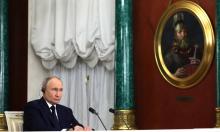Mysteries of the Amber Chamber
A woman from Russia's Rostov was the first to start restoration of the 8th wonder of the world
In the old times there were two suns above the Earth. Unfortunately one got broken to pieces; the pieces dropped into the ocean that now casts bits of "the solar stone" ashore. People call these pieces amber.
It is a nice legend about amber; it slightly reminds of the story of creation, loss and restoration of the famous amber chamber in Tsarskoye Selo.
One woman from the Russian city of Rostov was one of the first people who believed that the amber chamber could be restored. What is more, she made first considerable contribution into the reconstruction process.
In 1976, Lyudmila Zaichikova was the director of the Kaliningrad regional history and art museum; at that very time an idea arose to create a museum of amber. A museum of this kind already existed in Koenigsberg (now Kaliningrad) before WWII. It was exactly the Koenigsberg museum where Germans first took the Tsarskoye Selo amber chamber in 1942. But at the end of the war the museum exhibits disappeared. Workers of the Kaliningrad museum decided to reconstruct the cultural treasure.
Some collector gave them a book with pictures and drawings of several items once exhibited at the Koenigsberg museum. It was decided to reconstruct some exhibits from the book. The museum officials asked specialists of the Leningrad painting center for help in the reconstruction works. Lyudmila Zaichikova says that they were lucky to have assistance of a very talented artist Henry Khazatsky.
Specialists of the museum settled upon an idea of reconstruction of some pictures from the disappeared amber chamber. It was decided that the size of a reconstructed amber chamber will make up one fifth of the original size of the lost amber chamber.
Soon laborious research work started. Researchers managed to get negatives of amber chamber items. The problem was that the images were black-and-white. It was quite a problem to restore the color spectrum of the solar stone of which the amber chamber was made judging by the negatives. The researchers suggested a brilliant solution: they made up a scale of different amber shades and made a black-and-white picture of the scale. During the reconstruction works the scale of amber shades was compared with the negatives of amber chamber exhibits so that reconstructed items agreed the originals by color.
One more problem that the restorers faced was the natural structure of amber that is called "soapy". Professional experts managed to make the stone look older; they changed the color so that amber was clear. The original sources mentioned some mysterious herb called alkan that helped make amber clear. Unfortunately it was impossible to find the herb; that is why it was decided to hold several experiments when amber was boiled in acids and exposed to rays to achieve better clarity.
All kinds of experiments required money; Lyudmila Zaichikova usually addressed an official overseeing culture problems in the regional administration. She got finance each time she asked. Once when Lyudmila Zaichikova again asked for money necessary for the reconstruction works, the regional administration dropped a hint that the research group must apply to the Soviet Ministry of Culture for financing. Lyudmila sent a written request to the ministry and soon got a telephone call from Moscow. The higher authorities wanted to know for what purpose the researchers from Kaliningrad wanted to get money. The sum necessary for completion of the reconstruction works approached 500,000 rubles. In order to appropriate such a sum the ministry wanted to see items already reconstructed by that moment. When the research group brought already reconstructed large amber picture and two life-sized fragments, a conference hall where governmental sessions were traditionally held was opened especially for the exposition. The exposition was situated close to an office of Culture Minister Yury Melentyev. Within ten days of the exhibition, the period within which a decision on financing of the reconstruction project was discussed, the minister showed the exposition to guests.
Then Lyudmila Zaichikova got back to Kaliningrad, painters got back to Leningrad where they continued working on the project. Soon assistant of the reconstruction works Henry Khazatsky called Lyudmila and said it was ordered to make the items under reconstruction ready for an exposition that would be dedicated to a visit of Leningrad regional Communist Party Committee First Secretary Romanov.
As it turned out, the minister of culture once told Romanov about the wonderful Leningrad restorers working on the amber chamber. The conversation turned out to be decisive for Kaliningrad: as soon as the first secretary of the Leningrad regional communist party committee Romanov learnt about the wonderful exhibits, he never let the amber chamber out of Leningrad. Only once the amber chamber left Leningrad for an exhibition of restoration works held in Paris.
Lyudmila Zaichikova says it was quite a problem to persuade the Leningrad reconstruction team to compensate money spent by Kaliningrad on the works. Soon her family moved to Rostov-on-Don. When Lyudmila learnt that the reconstruction of the amber chamber was completed by the 300th anniversary of St.Petersburg she immediately recollected how the works started many years ago. She had an intention to meet with Henry Khazatsky, whose name for unknown reasons wasn't mentioned in the press in connection with the amber chamber reconstruction. It would be a nice moment to see him and remember how they started the restoration works that later developed into complete reconstruction of the amber chamber.
Subscribe to Pravda.Ru Telegram channel, Facebook, RSS!





